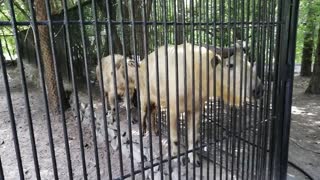Premium Only Content

Cheetahs are very beautiful and dangerous
The principle of hunting
Unlike other felids, cheetahs hunt by stalking prey, rather than attacking from ambush. This is due to the fact that the natural habitat of cheetahs and their hunting objects is an open area and, as a result, almost complete lack of opportunities for ambushes. First, they approach the chosen victim at a distance of about 10 meters (with almost no hiding), and then try to catch it in a short high-speed race. In pursuit of the victim, they reach speeds of up to 130 km/h, accelerating to 75 km / h in 2 seconds. The Cheetah runs in jumps of 6-8 m long, taking less than 0.5 seconds for each jump. During a sprint race, the Cheetah's breathing rate increases up to 150 times per minute[10] [11]. The Cheetah is also able to quickly change the direction of running. While running, the Cheetah's claws act as spikes on cleats. Flexible spine allows you to run, almost without lifting your paws from the ground, and keep your head at the same height. The tail helps maintain balance when running. In the eyes, the zone of clear visibility passes through a solid horizontal stripe, so as not to lose sight of the prey when it turns sharply to the side (sharp high — speed turns are quite effective and often used by ungulates as a way to break away from the pursuit of a predator). The Cheetah usually knocks its prey down with a blow of its front paw, using a claw located on the inside of the wrist, and then strangles it. The kinetic energy carried by the body of a very fast-moving Cheetah helps to knock down a larger and heavier animal than itself. The Cheetah's rapid run lasts a maximum of twenty seconds at a distance of no more than 400 m. Such a jerk requires such a flow of oxygen from the muscles that the intensively working heart and even the bulky lungs of the Cheetah cannot fill. And if the victim is not able to catch up with the first hundred meters, the Cheetah simply stops chasing[12]. Despite the high speed, only in about 50% of cases the animal being chased by the Cheetah becomes its prey. In Africa, the Cheetah is the weakest of the large predators. Hyenas, leopards and lions often take prey from cheetahs[13], often taking advantage of the fact that the Cheetah needs up to half an hour to rest after a high-speed chase. Cheetah eats only those animals that he has killed himself, sometimes drags the prey into the bushes to hide it from other predators, and eats later, but more often hunts each time again.
-
 0:08
0:08
AleksandrMm
4 years agohow beautiful and how dangerous
149 -
 0:41
0:41
royals99
4 years ago $0.02 earnedVery beautiful
254 -
 0:26
0:26
Welcome
4 years ago $0.04 earnedVery beautiful white buffaloes.
1622 -
 0:08
0:08
walnut0505
4 years ago $0.06 earnedVery beautiful rainbow
2204 -
 0:11
0:11
Vlasov
4 years agoVery beautiful kitty
135 -
 0:16
0:16
Shouman
4 years agoBeautiful nature very very good
61 -
 0:21
0:21
vavkirill
4 years agoVery beautiful dandelion.
84 -
 0:32
0:32
vavkirill
4 years agoVery beautiful geranium.
611 -
 0:13
0:13
GAR
4 years agoVery beautiful clouds
1071 -
 0:35
0:35
MDanial
4 years agoVery beautiful slowmo snowfall.
751